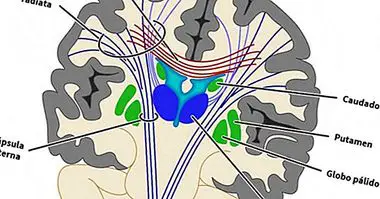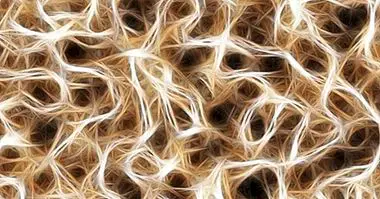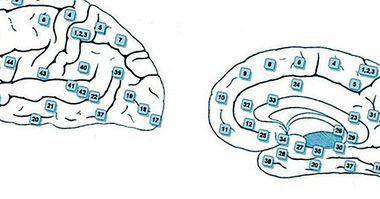Cerebral amygdala: structure and functions
Surprise, fear, anguish, affection, affection, joy, excitement ... All these words denote different emotions that we all feel in everyday life .
These are reactions that we have before stimuli that can come from outside (for example see a spider, a baby or that you communicate your long-awaited ascent) and from the inside of the person (a thought or memory that makes you suffer or feel happy). These reactions, at the brain level, depend on a series of circuits that are able to organize and connect perception and emotion, being the limbic system the main system responsible for this, and within this system the amygdala being one of the main nuclei.
In the present article we will focus on this structure, the amygdala, in order to visualize what it is and some of its main functions .
What is the amygdala?
The amygdala is a subcortical structure located in the inner part of the medial temporal lobe . This element has connections with the vast majority of the brain, being a nucleus of special relevance that can affect the whole nervous system and the functionality of the organism.
It is a key element for survival, because its main function is to integrate the emotions with the response patterns corresponding to these , provoking a response at the physiological level or the preparation of a behavioral response. It is also responsible for coordinating the areas that notice the somatic expression of emotion and the cerebral cortex responsible for the conscious feeling, with which it has a role of great relevance in the evaluation of the emotional meaning of the experiences.
The amygdala is, then, the main core of emotion control and feelings in the brain, also controlling the responses of satisfaction or fear. Its connections not only produce an emotional reaction, but due to its connection with the frontal lobe it also allows the inhibition of behaviors.
Now, the amygdala is not a simple "piece" of the human brain, with a predictable and well-known functioning pattern. In fact, none of the structures of the brain is like that, but in the case of the amygdala this is even more evident, keeping in mind that It is related to many other areas of the central nervous system . It is a complex structure, being an almond-shaped structure located in the limbic system of the brain. It is configured by different parts, with what sometimes also receives the name of amygdal complex.

Parts of the amygdaloid complex
As we said the amygdala is not a uniform structure, but it is divisible into various sub-elements . Among them, the following stand out:
Corticomedial nucleus
This part of the amygdalin complex has a great involvement in the uptake of pheromones, participating to a large extent in the control of both male and female sexual behavior. It also participates in hormonal control and in the response of satiation during the ingestion.
Basolateral nuclei
Its main participation is in the control of the intake through the feeling of fullness . In the same way, its involvement in the realization and learning of learned emotional responses, such as reactions to fear of different stimuli, is paramount.
Central core
This nucleus has the greatest participation in the expression of the emotional response , affecting both at a physiological level, producing the sensations and physical reactions that provoke emotions and having a large participation in the autonomic nervous system, as behavioral by allowing the performance of behaviors that respond to the sensations that produce the perceptions.
Likewise, this nucleus also affects the genesis and maintenance of feelings, which are differentiated from emotions by being psychophysiological thought patterns and reactivity maintained in time and less specific to a specific situation.
Functions of the amygdaloid complex
As mentioned, the amygdala is a complex structure and vital for survival, participating and being linked in a large number of psychological and physiological phenomena . Let's see some of them below:
1. Integration of emotions and autonomous responses
The amygdala manages with great precision the emission or inhibition of emotional responses both consciously and unconsciously, being its most studied function and one of the most relevant. It allows to associate experiences that we experience feelings of gratification or aversion. Participates in both positive emotions and reactions of joy or happiness as in other emotions of a more adaptive nature, as we will see in the next point.
two.Fear management and fight / flight reaction
In this aspect, one of the main functions of the amygdala and the fact that it is a key piece of survival is the management of fear . At a phylogenetic level, this nucleus has allowed the survival of our species, since it is what allows us to react after perceiving a potentially threatening stimulus for physical integrity, stimulating or inhibiting the fight / flight response. In fact, lesions in the amygdala can provoke extremely aggressive reactions and the loss of fear, with all the repercussions that the absence of this feeling can imply.
3. Emotional learning
The associative and conditioned learning are also influenced to a great extent by the performance of the amygdala . This structure allows the choice of strategies to be applied in the presence of stimuli, as well as detecting situations in which said strategies are also applicable. This is due to the link between emotion and cognition, as well as the maintenance of motivation by linking one's goals to concrete feelings.
4. Memory
In addition to the learning process, the amygdala also affects the structuring of memories . This is due to the association of memories with emotional states, which allow a greater connection and fixation of the material to remember, allowing its consolidation.
In fact, even when the hippocampus fails and does not allow for the storage of certain memories, the amygdala allows a certain emotional memory of a situation to be preserved, which makes it possible, for example, to be very afraid of dogs (emotional memory). without remembering why this happened (due to the stress that was suffered in a traumatic event with a dog, that "narrative" memory of what happened has not been conserved).
5. Sexual behavior regulation
Sexual behavior is also influenced by the performance of the amygdala . In addition to allowing the association of different stimuli with pleasure, the emotional bond between individuals and their association with the maintenance of intimate relationships are due, among other structures, to the amygdaloid complex.
6. Aggressiveness
The amygdala is also linked to aggression . The studies carried out so far indicate that a malfunction of this can cause the loss of reactions of aggressiveness and self-defense, while a hyperstimulation of the tonsillar complex causes extremely aggressive and violent reactions.
Saciation response
Another aspect in which the amygdala has some influence is in the control of intake, contributing greatly to the maintenance of body homeostasis through its influence on the perception of satiation.
Bibliographic references:
- Kandel, E.R .; Schwartz, J.H. & Jessell, T.M. (2001). Principles of neuroscience. Fourth edition. McGraw-Hill Interamericana. Madrid.
- Méndez-Bértolo, C .; Moratti, S .; Toledano, R .; López-Sosa, F .; Martínez-Álvarez, R .; Mah, Y.H .; Vuilleumier, P .; Gil-Nagel, A. & Strange, B.A. (2016). "A fast pathway for fear in human amygdala", Nature Neuroscience.
- Nieuwenhuys, Voogd & van Huijzen (2009). The Human Central Nervous System. 4th Edition. Editorial Panamericana Medical. Madrid.



















